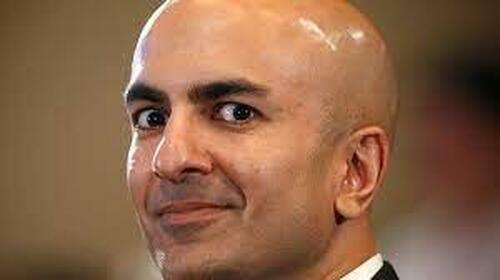Authored by Ven Ram, Bloomberg cross-asset strategist,
Treasury yields at the back end of the curve may stay higher for longer if Neel Kashkari is right about the short-run neutral rate.
Core PCE has averaged 2.9% so far this year, above the 2.6% the Fed estimated in its March dot plot, which itself marked an upward revision. While the April jobs data was softer than forecast, the average jobless rate this year is just 3.8% - well below levels that the Fed reckons will be needed to bring the labor market back into balance.
The policy committee “has more work to do” if inflation is going to settle around 3%, Kashkari commented in his latest essay posted on the Fed Minneapolis website.
For good measure, he has also penciled in a higher short-run neutral rate.
The neutral rate, where an economy is at full employment and inflation steady, is still elevated at 1.12%, based on the latest update of the Laubach-Williams model:
That compares with the Fed’s implicit assumption of a 60-basis point real neutral rate, based on its March summary of economic projections.
If core PCE were to bob around 3%, as Kashkari fears, and assuming the Laubach-Williams model provides a more realistic reading of the real neutral rate, the implied nominal policy rate would be north of 4% - making the current rate less restrictive.
This is why Kashkari remarked that there is the prospect of interest rates having to go higher, although he added that it isn’t the most likely scenario (note also that he doesn’t vote on monetary policy this year).
However marginal that prospect may look now, market pricing must reflect the possibility of such a scenario.
And at around 4.47%, Treasury 10-year yields are doing just that.
With so many factors sapping sentiment, longer-dated Treasuries will find it hard to rally just yet.
Authored by Ven Ram, Bloomberg cross-asset strategist,
Treasury yields at the back end of the curve may stay higher for longer if Neel Kashkari is right about the short-run neutral rate.
Core PCE has averaged 2.9% so far this year, above the 2.6% the Fed estimated in its March dot plot, which itself marked an upward revision. While the April jobs data was softer than forecast, the average jobless rate this year is just 3.8% - well below levels that the Fed reckons will be needed to bring the labor market back into balance.
The policy committee “has more work to do” if inflation is going to settle around 3%, Kashkari commented in his latest essay posted on the Fed Minneapolis website.
For good measure, he has also penciled in a higher short-run neutral rate.
The neutral rate, where an economy is at full employment and inflation steady, is still elevated at 1.12%, based on the latest update of the Laubach-Williams model:
That compares with the Fed’s implicit assumption of a 60-basis point real neutral rate, based on its March summary of economic projections.
If core PCE were to bob around 3%, as Kashkari fears, and assuming the Laubach-Williams model provides a more realistic reading of the real neutral rate, the implied nominal policy rate would be north of 4% - making the current rate less restrictive.
This is why Kashkari remarked that there is the prospect of interest rates having to go higher, although he added that it isn’t the most likely scenario (note also that he doesn’t vote on monetary policy this year).
However marginal that prospect may look now, market pricing must reflect the possibility of such a scenario.
And at around 4.47%, Treasury 10-year yields are doing just that.
With so many factors sapping sentiment, longer-dated Treasuries will find it hard to rally just yet.


